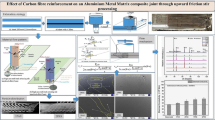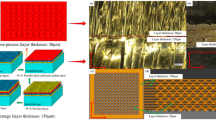Abstract
Ultrasonic vibration-assisted grinding (UVAG) is an effective method for high-quality and efficient processing of advanced composite materials. However, the material removal and defect formation mechanism of SiC particle-reinforced aluminum matrix (SiCp/Al) composites in UVAG processing are still unclear. This limits the application of UVAG in composite processing. In this work, a microstructure-based finite element model, in which the properties of SiC particle, Al matrix, and the interfacial layer between SiC particle and Al matrix are considered, has been developed in order to more accurately describe the deformation and failure behavior of SiCp/Al composites in the ultrasonic vibration-assisted grinding process. The influences of complex interactions between tool, particle, and matrix under different tool-workpiece contact modes on material removal and surface defect formation mechanism are analyzed based on the proposed model. Simulation results show that groove and pit defects are more likely to occur in the tool-workpiece continuous contact mode while voids and particle fractures often appear in the tool-workpiece intermittent contact mode. The validity of the proposed model is verified by the corresponding ultrasonic vibration-assisted scratching experiments in terms of surface morphology, defect characteristics, and scratching force. Experimental results are found to correspond well with the outcome of the simulation. The findings reported in this work provide a theoretical basis for exploring effective methods to reduce machining defects and improve the quality of machined surfaces.























Similar content being viewed by others
Abbreviations
- UVAG:
-
Ultrasonic vibration-assisted grinding
- SiCp/Al:
-
Silicon carbide particle-reinforced aluminum matrix composites
- UVAM:
-
Ultrasonic vibration-assisted machining
- CG:
-
Conventional grinding
- RUVAS:
-
Rotary ultrasonic vibration-assisted scratch
- \({v}_{s}\) :
-
Cutting speed
- \(f\) :
-
Frequency of ultrasonic vibration
- \(A\) :
-
Ultrasonic amplitude
- \(\theta\) :
-
Top angle of the abrasive grain
- \(\sigma\) :
-
Von Mises plastic equivalent stress
- \(\overline\sigma\) :
-
Stress triaxiality
- \(\varepsilon\) :
-
Equivalent plastic strain
- \(\dot{\varepsilon }\) :
-
Plastic strain rate
- \({\dot{\varepsilon }}_{0}\) :
-
Reference strain rate
- \({{\varepsilon }_{f}}^{pl}\) :
-
Critical equivalent plastic strain
- \(\Delta {\overline{\varepsilon }}^{pl}\) :
-
Increment of equivalent plastic strain
- T :
-
Temperature of material
- T room :
-
Room temperature
- T melt :
-
Melting temperature
- D :
-
Damage parameter in J-C
- a,b,n,c,m :
-
J-C strength model constants for the Al2024
- d 1, d 2, d 3, d 4, d 5 :
-
J-C damage constants for the Al2024
- \({\sigma }^{*}\) :
-
Normalized von Mises equivalent stress
- \({\sigma }_{i}^{*}\) :
-
Normalized intact equivalent stress
- \({\sigma }_{f}^{*}\) :
-
Normalized fractured equivalent stress
- \(\dot{\sigma }\) :
-
Actual von Mises equivalent stress
- \({\sigma }_{\text{HEL}}\) :
-
Equivalent stress at the Hugoniot elastic limit
- P :
-
Actual pressure
- \({P}^{*}\) :
-
Normalized pressure
- \({P}_{\text{HEL}}\) :
-
Pressure at the Hugoniot elastic limit
- \({T}^{*}\) :
-
Normalized maximum tensile hydrostatic pressure
- \(\dot{T}\) :
-
Maximum tensile pressure
- \({\dot{\varepsilon }}^{*}\) :
-
Dimensionless strain rate
- \({\overline{\varepsilon }}_{f}^{pl}(P)\) :
-
Equivalent plastic strain to fracture under constant pressure
- \({D}^{*}\) :
-
Damage parameter in JH-2
- \(\omega\) :
-
Damage initiation parameter
- \({A}^{*}\),\({B}^{*}\),\({C}^{*}\),\(M\),\(N\),\({D}_{1}\),\({D}_{2}\) :
-
Material parameters of SiC for the JH-2 model
- \({K}_{1}\),\({K}_{2}\),\({K}_{3}\) :
-
Constants of the JH-2 model
- \(\rho\) :
-
Current density
- \(\rho_0\) :
-
Reference density
- \({t}_{n}^{0}\),\({t}_{s}^{0}\),\({t}_{t}^{0}\) :
-
Peak values of the nominal stress
References
Ren SB, Qu XH, Guo J, He XB, Qin ML, Shen XY (2009) Net-shape forming and properties of high volume fraction SiCp/Al composites. J Alloy Compd 484:256–262. https://doi.org/10.1016/j.jallcom.2009.04.074
Sekhar R, Singh TP (2015) Mechanisms in turning of metal matrix composites: a review. J Mater Res Technol-JMRT 4:197–207. https://doi.org/10.1016/j.jmrt.2014.10.013
Jagadeesh GV, Setti SG (2020) A review on micromechanical methods for evaluation of mechanical behavior of particulate reinforced metal matrix composites. J Mater Sci 55:9848–9882. https://doi.org/10.1007/s10853-020-04715-2
Zhou JK, Lu MM, Lin JQ, Zhou XQ, Guo MQ, Du YS (2022) Investigation of surface integrity transition of SiCp/Al composites based on specific cutting energy during ultrasonic elliptical vibration assisted cutting. J Manuf Process 79:654–665. https://doi.org/10.1016/j.jmapro.2022.04.067
Das DK, Mishra PC, Singh S, Thakur RK (2015) Tool wear in turning ceramic reinforced aluminum matrix composites-a review. J Compos Mater 49:2949–2961. https://doi.org/10.1177/0021998314558955
Liu C, Gao L, Jiang XG, Xu WW, Liu SN, Yang T (2020) Analytical modeling of subsurface damage depth in machining of SiCp/Al composites. Int J Mech Sci 185:16. https://doi.org/10.1016/j.ijmecsci.2020.105874
Ge YF, Xu JH, Yang H, Luo SB, Fu YC (2008) Workpiece surface quality when ultra-precision turning of SiCp/Al composites. J Mater Process Technol 203:166–175. https://doi.org/10.1016/j.jmatprotec.2007.09.070
Yang ZC, Zhu LD, Zhang GX, Ni CB, Lin B (2020) Review of ultrasonic vibration-assisted machining in advanced materials. Int J Mach Tools Manuf 156. https://doi.org/10.1016/j.ijmachtools.2020.103594
Huang C, Zhou M, Zhang HJ (2022) Investigations on the micro-interactions of grit-workpiece and forces prediction in ultrasonic vibration side grinding of optical glass. J Mater Process Technol 300:19. https://doi.org/10.1016/j.jmatprotec.2021.117415
Zahedi A, Tawakoli T, Akbari J (2015) Energy aspects and workpiece surface characteristics in ultrasonic-assisted cylindrical grinding of alumina–zirconia ceramics. Int J Mach Tools Manuf 90:16–28. https://doi.org/10.1016/j.ijmachtools.2014.12.002
Kumar V, Singh H (2018) Regression analysis of surface roughness and micro-structural study in rotary ultrasonic drilling of BK7. Ceram Int 44:16819–16827. https://doi.org/10.1016/j.ceramint.2018.06.117
Zhang MH, Pang ZX, Jia YX, Shan CW (2022) Understanding the machining characteristic of plain weave ceramic matrix composite in ultrasonic-assisted grinding. Ceram Int 48:5557–5573. https://doi.org/10.1016/j.ceramint.2021.11.100
Zhao B, Liu CS, Zhu XS, Xu KW (2002) Research on the vibration cutting performance of particle reinforced metallic matrix composites SiCp/Al. J Mater Process Technol 129:380–384. https://doi.org/10.1016/S0924-0136(02)00696-9
Dong GJ, Zhang HJ, Zhou M, Zhang YJ (2013) Experimental investigation on ultrasonic vibration-assisted turning of SiCp/Al composites. Mater Manuf Process 28:999–1002. https://doi.org/10.1080/10426914.2012.709338
Bai W, Roy A, Sun RL, Silberschmidt VV (2019) Enhanced machinability of SiC-reinforced metal-matrix composite with hybrid turning. J Mater Process Technol 268:149–161. https://doi.org/10.1016/j.jmatprotec.2019.01.017
Zhou J, Lu M, Lin J, Du Y (2021) Elliptic vibration assisted cutting of metal matrix composite reinforced by silicon carbide: an investigation of machining mechanisms and surface integrity. J Mater Res Technol-JMRT 15:1115–1129. https://doi.org/10.1016/j.jmrt.2021.08.096
Zhou M, Wang M, Dong GJ (2016) Experimental Investigation on Rotary Ultrasonic Face Grinding of SiCp/Al Composites. Mater Manuf Process 31:673–678. https://doi.org/10.1080/10426914.2015.1025962
Dong ZG, Zheng FF, Zhu XL, Kang RK, Zhang B, Liu ZQ (2017) Characterization of material removal in ultrasonically assisted grinding of SiCp/Al with high volume fraction. Int J Adv Manuf Technol 93:2827–2839. https://doi.org/10.1007/s00170-017-0676-4
Feng PF, Liang GQ, Zhang JF (2014) Ultrasonic vibration-assisted scratch characteristics of silicon carbide-reinforced aluminum matrix composites. Ceram Int 40:10817–10823. https://doi.org/10.1016/j.ceramint.2014.03.073
Zha HT, Feng PF, Zhang JF, Yu DW, Wu ZJ (2018) Material removal mechanism in rotary ultrasonic machining of high-volume fraction SiCp/Al composites. Int J Adv Manuf Technol 97:2099–2109. https://doi.org/10.1007/s00170-018-2075-x
Zheng W, Wang YJ, Zhou M, Wang Q, Ling L (2018) Material deformation and removal mechanism of SiCp/Al composites in ultrasonic vibration assisted scratch test. Ceram Int 44:15133–15144. https://doi.org/10.1016/j.ceramint.2018.05.150
Dandekar CR, Shin YC (2012) Modeling of machining of composite materials: a review. Int J Mach Tools Manuf 57:102–121. https://doi.org/10.1016/j.ijmachtools.2012.01.006
Johnson GR, Cook WH (1983) A constitutive model and data for metals subjected to large strains, high strain rates and high temperatures. Proceedings 7th International Symposium on Ballistics. The Hague 19–21:541–547
Zheng W, Qu D, Qiao GC (2021) Multi-phase modeling of SiC particle removal mechanism in ultrasonic vibration-assisted scratching of SiCp/Al composites. Int J Adv Manuf Technol 113:535–551. https://doi.org/10.1007/s00170-021-06675-6
Johnson GR, Cook WH (1985) Fracture characteristics of three metals subjected to various strains, strain rates, temperatures and pressures. Eng Fract Mech 21:31–48. https://doi.org/10.1016/0013-7944(85)90052-9
Teng X, Wierzbicki T (2006) Evaluation of six fracture models in high velocity perforation. Eng Fract Mech 73:1653–1678. https://doi.org/10.1016/j.engfracmech.2006.01.009
Yu WW, Chen J, Ming WW, An QL, Chen M (2021) Experimental and FEM study of cutting mechanism and damage behavior of ceramic particles in orthogonal cutting SiCp/Al composites. Ceram Int 47:7183–7194. https://doi.org/10.1016/j.ceramint.2020.11.072
Johnson GR, Holmquist TJ (1994) An improved computational constitutive model for brittle materials. AIP Conf Proc 309:981–984. https://doi.org/10.1063/1.46199
Holmquist TJ, Johnson GR (2005) Characterization and evaluation of silicon carbide for high-velocity impact. J Appl Phys 97:093502. https://doi.org/10.1063/1.1881798
Zou ZM, Lee H (2017) A cohesive zone model taking account of the effect of through-thickness compression. Compos Pt A-Appl Sci Manuf 98:90–98. https://doi.org/10.1016/j.compositesa.2017.03.015
Su YS, Ouyang QB, Zhang WL, Li ZQ, Guo Q, Fan GL, Zhang D (2014) Composite structure modeling and mechanical behavior of particle reinforced metal matrix composites. Mater Sci Eng A-Struct Mater Prop Microstruct Process 597:359–369. https://doi.org/10.1016/j.msea.2014.01.024
Wu Q, Xu WX, Zhang LC (2019) Machining of particulate-reinforced metal matrix composites: an investigation into the chip formation and subsurface damage. J Mater Process Technol 274:116315. https://doi.org/10.1016/j.jmatprotec.2019.116315
Funding
This work was supported by the National Natural Science Foundation of China (Grant No. 51975153).
Author information
Authors and Affiliations
Contributions
Haotao Wang: conceptualization, simulation modeling, software, experimental work, writing (original draft preparation), reviewing, and editing.
Haijun Zhang: investigation, software, and writing (reviewing and editing).
Ming Zhou: conceptualization, funding acquisition, supervision, and writing (reviewing and editing).
Corresponding author
Ethics declarations
Competing Interests
The authors declare no competing interests.
Additional information
Publisher's Note
Springer Nature remains neutral with regard to jurisdictional claims in published maps and institutional affiliations.
Rights and permissions
Springer Nature or its licensor (e.g. a society or other partner) holds exclusive rights to this article under a publishing agreement with the author(s) or other rightsholder(s); author self-archiving of the accepted manuscript version of this article is solely governed by the terms of such publishing agreement and applicable law.
About this article
Cite this article
Wang, H., Zhang, H. & Zhou, M. Study on surface defect formation mechanism in ultrasonic vibration-assisted grinding of SiCp/Al composites. Int J Adv Manuf Technol 129, 375–397 (2023). https://doi.org/10.1007/s00170-023-12253-9
Received:
Accepted:
Published:
Issue Date:
DOI: https://doi.org/10.1007/s00170-023-12253-9




